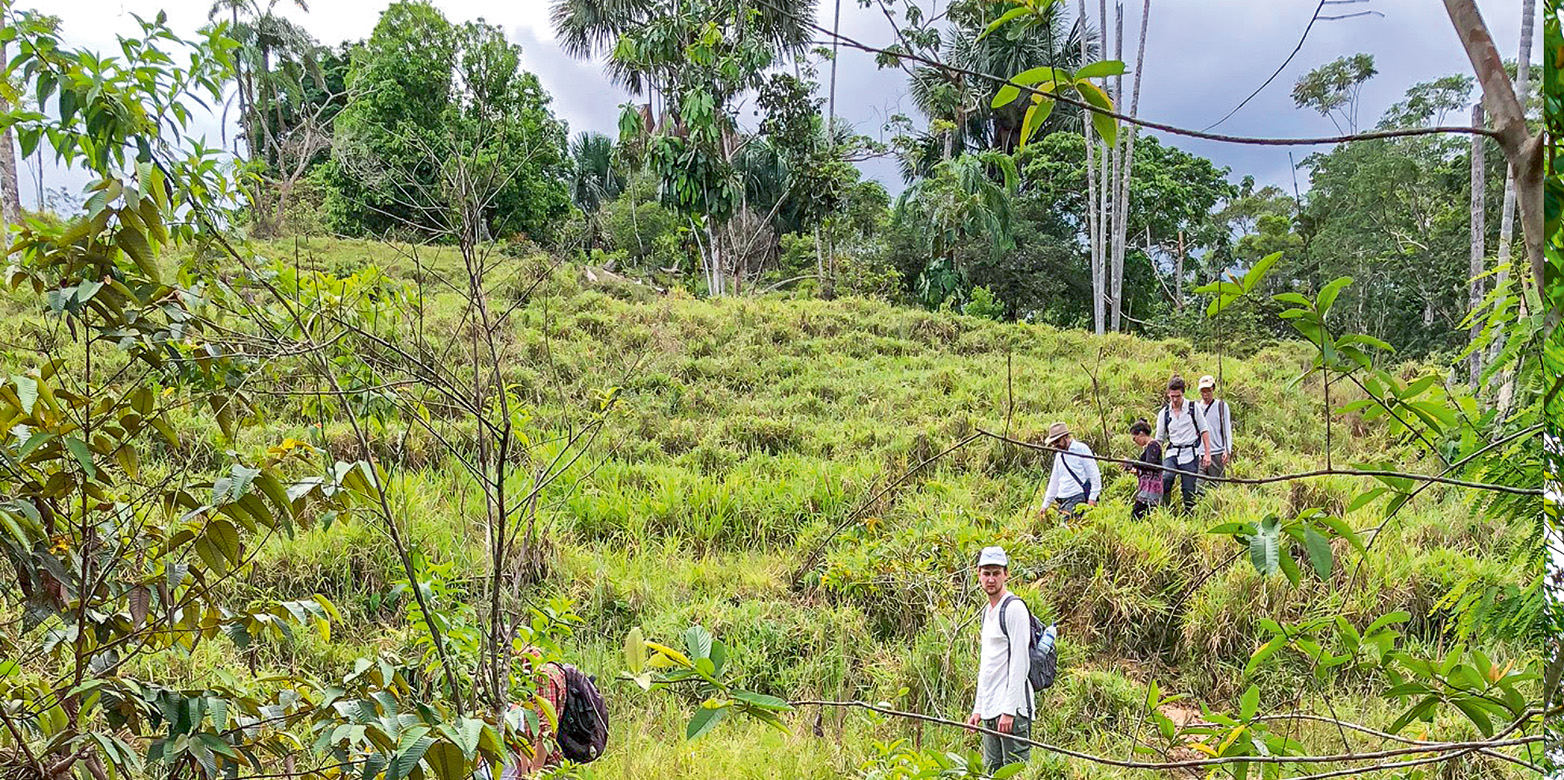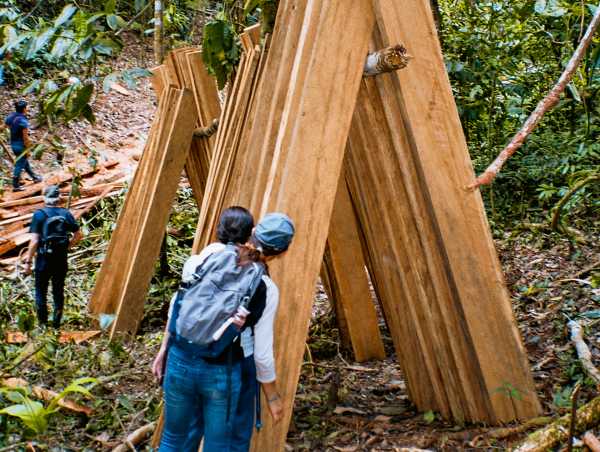A university for the guardians of the rainforest
The Inga hope a university will keep their indigenous heritage alive, safeguard the natural habitat of the Colombian rainforest and give the younger generation a future. Anne Lacaton, Professor of Architecture and Design, spent two semesters supporting the project with her students.

It’s late one evening in October 2019, and a group of students from ETH Zurich and Javeriana University are crossing the Caquetá river on their way back to Villagarzón. The sky above them is clear and black, studded with the sparkling stars of the Milky Way. The river is as dark and smooth as a pool of oil, and the boat is surrounded by the polyphonic humming of tropical insects in the dense tropical forest on both banks. “The students were so quiet,” says Zurich-based artist Ursula Biemann. “That night-time boat trip and the sheer beauty of the moment is something we will never forget.”
Armed drug traffickers and environmental destruction
This extraordinary experience was the culmination of hours of hiking through the lush, almost impenetrable terrain of Putumayo – a trip that confronted the students not only with the wonders of nature, but also the more harrowing aspects of life in this region. Their route took them past oil platforms that are steadily encroaching on the rainforest, coca plantations tended by farmers living in abject poverty, and the whining sound of chainsaws clearing trees to make room for herds of cattle. The 17 students had travelled to southern Colombia to get first-hand experience of a territory they had been studying for weeks – a territory that is home to the Inga people.
The Inga are one of Colombia’s 87 indigenous ethnic groups. They are descended from the Incas, who, in the 15th century, expanded their empire along the Andes mountain chain and made their way through the Ecuadorian Amazon basin to the Colombian rainforest. Today, there are over 15,000 Inga scattered across tens of thousands of hectares and multiple Colombian departments. They live in fragmented and often hard-to-access territories dotted across an area stretching from the foothills of the Andes to the Amazon basin. Many Inga earn a living growing coca, the raw material used for producing cocaine. The region is also known for opium cultivation, which has led to large-scale deforestation. As a result, Inga territory was long at the heart of armed conflicts over drug production and trafficking that had raged between FARC guerrillas, paramilitaries and the army since the 1960s. The Inga were largely abandoned to their fate in the face of rampant violence and persecution.
In 2004, their predicament prompted an extraordinary act of self-empowerment in the town of Aponte, which is situated at an altitude of 2,000 metres. Inspired by an indigenous women’s organisation and with government support, the local community began to reforest and cultivate areas that had been degraded by drug production, reclaiming the soil through the use of organic fertilisers and plentiful manual labour. Instead of coca, they planted coffee and fruit trees. The driving force behind this transformation was Hernando Chindoy, a charismatic community leader who represents the Inga on their quest for greater self-determination, resistance and cultural renewal.
The humility of not knowing

Zurich-based video artist Ursula Biemann met Chindoy in the summer of 2018 while she was working on an assignment for the Art Museum of the National University of Colombia. Her preparation included a five-week excursion through Putumayo department. Access to this region had been restored in 2016 following the signing of a peace and disarmament agreement between the Colombian government and FARC, and Chindoy signed up as her guide. “On the last day, just before I left, Hernando said to me: ‘We want to establish a university here. Will you help us?’” Biemann carried his message back to Switzerland, telling Philip Ursprung about the Inga’s request for help. Ursprung, at that time the Dean of the Department of Architecture at ETH Zurich, responded positively to the idea, rounding up a group of professors so that Biemann could present the project.
The group included Anne Lacaton, Professor of Architecture and Design. “I’m always open to pursuing completely new avenues,” she says. The French architect is well known for her work with the architecture studio Lacaton & Vassal, which encompasses museums, social housing and the transformation of existing residential buildings, primarily in France. “In all our projects, we start from the perspective that we know nothing about the context in which we will be building,” says Lacaton, describing how she works. “That forces us to really open our eyes and find our own way of responding appropriately to each specific situation.” She describes this attitude as the humility of not knowing, and she also extended it to the project in the Colombian rainforest. Lacaton devoted a two-semester studio to the concept of an indigenous university. Right from the start, she insisted that her studio would not develop any ready-made solutions – that is, no concrete plans, visualisations or calculations for a university campus. Instead, she wanted to take a journey with the students to explore, document and understand the socio-economic, political and territorial context of the Inga people. “You can still be an architect without actually building anything,” Lacaton says, outlining her ideas of the architect as an ethnographer and the studio as a catalyst for articulating indigenous people’s needs.
Combining different cultures of knowledge
The Inga had their own ideas for “their” university right from the start of the process, says Ivan Vargas, a Colombian member of the project team. “When it comes to answering research questions, the indigenous people do more than just reading texts,” he explains. “One of the ways they approach learning and research is by visiting the ‘chagra’, a communally managed plot of land where crops are grown to feed the community and celebrate the diversity of plants. We see this as an equally important approach to learning.” The goal from the outset was therefore to embark on an inter-epistemic dialogue to bring together the learning and research traditions of the indigenous people with those of established modern science. This would provide a basis for ensuring the Inga people’s own store of knowledge – much of which is only transmitted orally by shamans – would survive into the 21st century.
Equally important is to make the university a space where the Inga can honour and develop their ethnic identity. Indigenous people are marginalised in Colombia – just as in the majority of South American countries – and their language and customs are increasingly threatened with extinction. Although the government has built primary schools for the Inga, a university education is only available in the cities of Medellin or Bogotá. But university courses in the city do not equip young Inga people with the skills they need to return to their community, so many of them never come back.
«Even without a campus, the university can at least start off in an existing school.»Anne Lacaton
Inga representatives therefore agreed that the key requirements for an indigenous university should include environmental studies and ecological agriculture, traditional medicine, and territorial governance based on indigenous ethics and Earth rights. The curriculum would be rounded off with linguistics, semiotics and history. The idea is for teaching to be provided on equal footing by indigenous masters of knowledge and Western professors, with the primary goal of learning with and from each other. At the same time, the university would act as a conservation centre to safeguard the region’s unique natural environment. Although parts of the Inga territory already have national park status, no park wardens have been trained, and no methods have been developed to protect the park against poachers, loggers and unlicensed copper and gold mines.
Decentralised and ecological
In June, the ETH students presented their work in a virtual event and discussed it with professors and experts from Switzerland and Colombia. In line with Lacaton’s concept, the five workgroups did not present any final architectural proposals, but instead elaborated five strategies for setting up a university. These included the idea of decentralising the campus and distributing it across the widely dispersed Inga communities. Suitable locations would depend on the course content in each case but could include an urban centre, an agricultural area in the lowlands and a cloud forest region at higher altitudes. One of the other groups delved deeper into the teaching content and came up with a suggested course curriculum including a breakdown of each semester. Other topics included consideration of ongoing decision-making processes and strategies for continuing to develop the university in the years ahead.
Lacaton and her students have now produced a book of essays, photographs, studies, plans and first-hand accounts from the field. This is currently being translated into Spanish. Ursula Biemann intends to return to the Putumayo region in autumn to continue her creative work and hopes to discuss the ideas with the Inga while she is there.
ETH also looks likely to continue with the project. Although Anne Lacaton became an emeritus professor in July, Teresa Galí-Izard – who was appointed as Professor of Landscape Architecture in January – has already expressed an interest in continuing work on the Inga university. Lacaton hopes that the indigenous university will soon be up and running: “Even without a campus, the university can at least start off in an existing school.” She thinks of the university not as a finished product, but rather as an ongoing, iterative process. “What’s interesting about this project is not only setting up an indigenous university in Colombia, but also what it can teach us about architectural projects in Europe,” Lacaton argues.



This text has been published in the current issue of the Globe magazine.
Comments
No comments yet